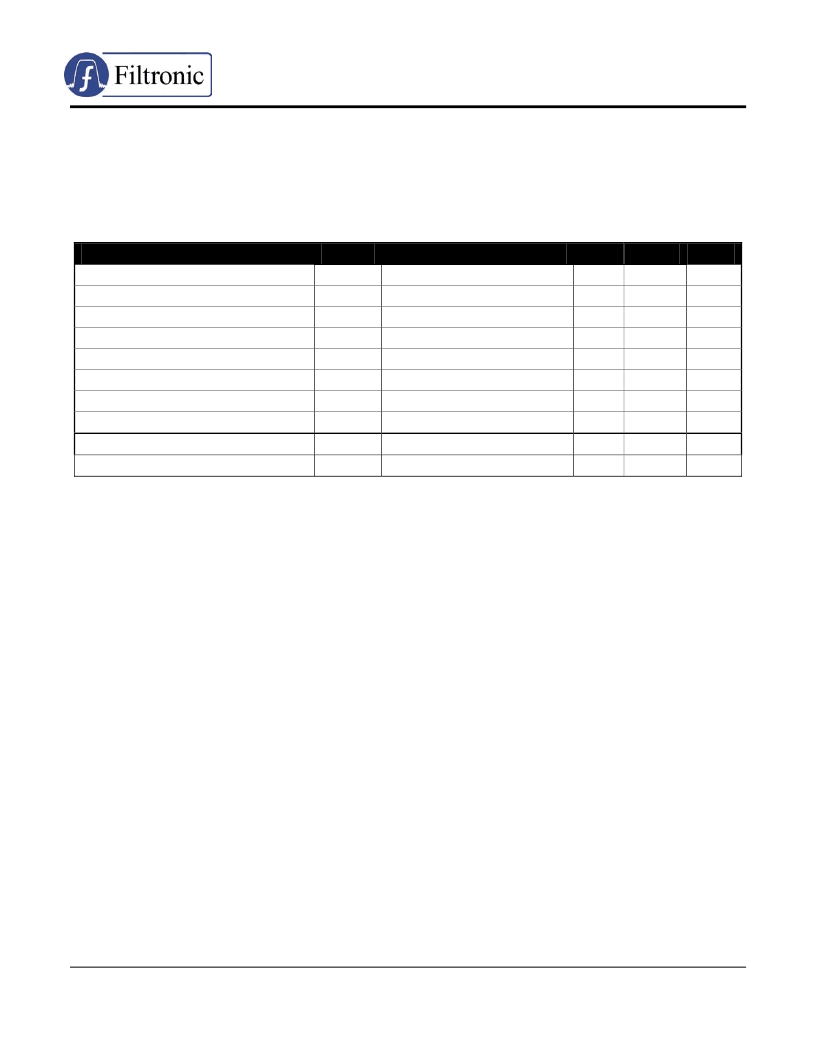- 您現(xiàn)在的位置:買(mǎi)賣(mài)IC網(wǎng) > PDF目錄370216 > FPD1000AS 1W PACKAGED POWER PHEMT PDF資料下載
參數(shù)資料
| 型號(hào): | FPD1000AS |
| 英文描述: | 1W PACKAGED POWER PHEMT |
| 中文描述: | 1W的包裝的電源PHEMT器件 |
| 文件頁(yè)數(shù): | 2/8頁(yè) |
| 文件大?。?/td> | 533K |
| 代理商: | FPD1000AS |

FPD1000AS
1W
P
ACKAGED
P
OWER P
HEMT
Phone:
+1 408 850-5790
Fax:
+1 408 850-5766
http://
www.filtronic.co.uk/semis
Revised:
05/26/05
Email:
sales@filcsi.com
RECOMMENDED OPERATING BIAS CONDITIONS
Drain-Source Voltage:
Quiescent Current:
From 5V to 10V
From 25% I
DSS
to 55% I
DSS
ABSOLUTE MAXIMUM RATINGS
1
Parameter
Drain-Source Voltage
Gate-Source Voltage
Drain-Source Current
Gate Current
RF Input Power
2
Channel Operating Temperature
Storage Temperature
Total Power Dissipation
Symbol
V
DS
V
GS
I
DS
I
G
P
IN
T
CH
T
STG
P
TOT
Comp.
Test Conditions
-3V < V
GS
< +0V
0V < V
DS
< +8V
For V
DS
> 2V
Forward / Reverse current
Under any acceptable bias state
Under any acceptable bias state
Non-Operating Storage
See De-Rating Note below
Min
-40
Max
12
-3
I
DSS
+20/-20
575
175
150
6.0
Units
V
V
mA
mA
mW
oC
oC
W
Gain Compression
Simultaneous Combination of Limits
3
1
T
Ambient
= 22
°
C unless otherwise noted
3
Users should avoid exceeding 80% of 2 or more Limits simultaneously
Under any bias conditions
2 or more Max. Limits
5
80
dB
%
2
Max. RF Input Limit must be further limited if input VSWR > 2.5:1
Notes
:
Operating conditions that exceed the Absolute Maximum Ratings will result in permanent damage to the device.
Total Power Dissipation defined as: P
TOT
≡
(P
DC
+ P
IN
) – P
OUT
, where:
P
DC
: DC Bias Power
P
IN
: RF Input Power
P
OUT
: RF Output Power
Total Power Dissipation to be de-rated as follows above 22
°
C:
P
TOT
= 3.5 - (0.04W/
°
C) x T
PACK
where T
PACK
=
source tab lead temperature above 22
°
C
(coefficient of de-rating formula is the Thermal Conductivity)
Example: For a 55
°
C source lead temperature: P
TOT
= 6.0 - (0.04 x (55 – 22)) = 4.68W
For optimum heatsinking, metal-filled through (Source) via holes should be used directly below the central
metallized ground pad on the bottom of the package.
Note on Thermal Resistivity:
The nominal value of 25
°
C/W is measured with the package mounted on a large
heatsink with thermal compound to ensure adequate (unsoldered) contact. The package temperature is referred to
the Source leads.
HANDLING PRECAUTIONS
To avoid damage to the devices care should be exercised during handling. Proper Electrostatic
Discharge (ESD) precautions should be observed at all stages of storage, handling, assembly, and
testing. This product has be tested to Class 1A (> 250V but < 500V) using JESD22 A114, Human
Body Model, and to Class A, (< 200V) using JESD22 A115, Machine Model.
相關(guān)PDF資料 |
PDF描述 |
|---|---|
| FPD1000V | CAP,SMD,TANT,22UF,20%,6.3V,A |
| FPD1050 | 0.75W POWER PHEMT |
| FPD1500DFN | LOW NOISE, HIGH LINEARITY PACKAGED PHEMTT |
| FPD1500P100 | 1W PACKAGED POWER PHEMT |
| FPD2000AS | 2W PACKAGED POWER PHEMT |
相關(guān)代理商/技術(shù)參數(shù) |
參數(shù)描述 |
|---|---|
| FPD1000AS_1 | 制造商:FILTRONIC 制造商全稱:FILTRONIC 功能描述:1W PACKAGED POWER PHEMT |
| FPD1000AS-EB | 制造商:FILTRONIC 制造商全稱:FILTRONIC 功能描述:1W PACKAGED POWER PHEMT |
| FPD1000V | 制造商:FILTRONIC 制造商全稱:FILTRONIC 功能描述:1W POWER PHEMT |
| FPD-101R008-0E | 功能描述:光纖連接器 3.2 Gbps RoHS:否 制造商:Molex 產(chǎn)品:Adapters 類型:8 Port with External Shutter 連接器類型:Adapter 模式:Multimode 光纖直徑: 顏色:Blue 附件類型:LC Adapter |
| FPD-102R008-0E | 制造商:FUJITSU 制造商全稱:Fujitsu Component Limited. 功能描述:4-Channel Optical Transceiver |
發(fā)布緊急采購(gòu),3分鐘左右您將得到回復(fù)。